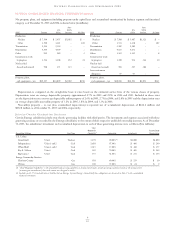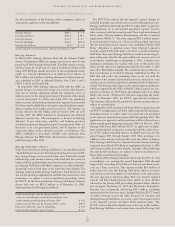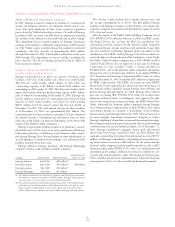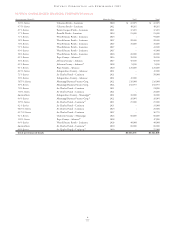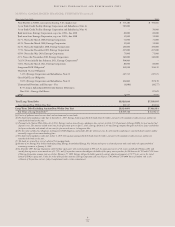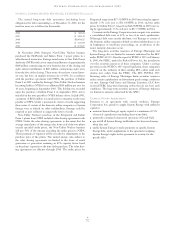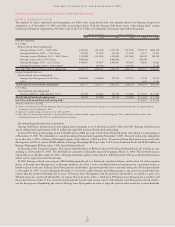Entergy 2005 Annual Report Download - page 77
Download and view the complete annual report
Please find page 77 of the 2005 Entergy annual report below. You can navigate through the pages in the report by either clicking on the pages listed below, or by using the keyword search tool below to find specific information within the annual report.
ENTERGY CORPORATION AND SUBSIDIARIES 2005
*
73
■Entergy Gulf States may not file a general base rate case in
Texas before June 30, 2007, with rates effective no earlier than
June 30, 2008, but may seek before then the recovery of certain
incremental purchased power capacity costs, adjusted for load
growth, not in excess of five percent of its annual base rate
revenues (as discussed above in “Deferred Fuel Costs,” in July
2005, Entergy Gulf States filed a request for implementation of
an incremental purchased capacity recovery rider); and
■Entergy Gulf States may recover over a period not to exceed
15 years reasonable and necessary transition to competition
costs incurred before the effective date of the legislation and
not previously recovered, with appropriate carrying charges
(as discussed above in “Filings with the PUCT and Texas Cities,”
in August 2005, Entergy Gulf States filed with the PUCT an
application for recovery of its transition to competition costs).
Entergy Gulf States made the January 2006 filing regarding the
identification of power region(s) required by the 2005 legislation,
and based on the statutory requirements for the certification of a
qualified power region (QPR), previous PUCT rulings, and
Entergy Gulf States’ geographical location, Entergy Gulf States
identified three potential power regions:
1. Electric Reliability Council of Texas (ERCOT) as the power
region and Independent Organization (IO);
2. Southwest Power Pool (SPP) as the power region and IO; and
3. the Entergy market as the power region and the Independent
Coordinator of Transmission (ICT) as the IO.
Based on previous rulings of the PUCT, and absent reconsidera-
tion of those rulings, Entergy Gulf States believes that the third
alternative – an ICT operating in Entergy’s market area – is not likely
to be a viable QPR alternative at this time. Accordingly, while
noting this alternative, Entergy Gulf States’ filing focuses on the
first two alternatives, which are expected to meet the statutory
requirements for certification so long as certain key implementation
issues can be resolved. Entergy Gulf States’ filing enumerated
and discussed the corresponding steps and a high-level schedule
associated with certifying either of these two power regions.
Entergy Gulf States’ filing does not make a recommendation
between ERCOT and the SPP as a power region. Rather, the filing
discusses the major issues that must be resolved for either of those
alternatives to be implemented. In the case of ERCOT, the major
issue is the cost and time related to the construction of facilities to
interconnect Entergy Gulf States’ Texas operations with ERCOT,
while addressing the interest of Entergy Gulf States’ retail
customers and certain wholesale customers in access to generation
outside of Texas. With respect to the SPP, the major issue is the
development of protocols that would ultimately be necessary to
implement retail open access.
Entergy Gulf States recommended that the PUCT open a project
for the purpose of involving stakeholders in the selection of the
single power region that Entergy Gulf States should request for
certification. Entergy Gulf States notes that House Bill 1567 also
directs Entergy Gulf States to file a transition to competition filing
no later than January 1, 2007. The contents of the January 1, 2007
filing will be affected by the power region selected. Accordingly,
Entergy Gulf States recommended that the goal of the project
should be to reach consensus on a power region in a timely manner
to inform Entergy Gulf States’ January 1, 2007 filing.
NOTE 3. INCOME TAXES
Income tax expenses from continuing operations for 2005, 2004, and
2003 consist of the following (in thousands):
2005 2004 2003
Current:
Federal(a) (b) $ (306,524) $ 67,924 $ (725,319)
Foreign 13,290 (2,231) 8,284
State(a) (b) (27,212) 38,324 23,316
Total(a) (b) (320,446) 104,017 (693,719)
Deferred – net 898,384 282,275 1,218,796
Investment tax credit
adjustments – net (18,654) (20,987) (27,644)
Income tax expense from
continuing operations $559,284 $365,305 $ 497,433
(a) The actual cash taxes paid were $98,072 in 2005, $28,241 in 2004, and $188,709
in 2003. Entergy Louisiana’s mark-to-market tax accounting election significantly
reduced taxes paid in 2002. In 2001, Entergy Louisiana changed its method of
accounting for tax purposes related to its wholesale electric power contracts. The most
significant of these is the contract to purchase power from the Vidalia project
(the contract is discussed in Note 8 to the consolidated financial statements). The new
tax accounting method has provided a cumulative cash flow benefit of approximately
$664 million through 2005, which is expected to reverse in the years 2006 through
2031 depending on several variables, including the price of power. The election did not
reduce book income tax expense.
(b) In 2003, the domestic utility companies and System Energy filed, with the Internal
Revenue Service (IRS), a change in tax accounting method notification for their
respective calculations of cost of goods sold. The adjustment implemented a simplified
method of allocation of overhead to the production of electricity, which is provided under
the IRS capitalization regulations. The cumulative adjustment placing these companies
on the new methodology resulted in a $2.8 billion deduction on Entergy’s 2003 income
tax return. There was no cash benefit from the method change in 2003. In addition, on
a consolidated basis, there was no cash benefit from this method change in 2004 or 2005.
The IRS has issued new proposed regulations effective in 2005 that may preclude a
significant portion of the benefit of this tax accounting method change. In 2005, the
domestic utility companies and System Energy filed a notice with the IRS of a new
tax accounting method for their respective calculations of cost of goods sold. This new
method is also subject to IRS scrutiny.
Total income taxes from continuing operations differ from the
amounts computed by applying the statutory income tax rate to
income before taxes. The reasons for the differences for the years
2005, 2004, and 2003 are (in thousands):
2005 2004 2003
Computed at statutory rate (35%) $534,743 $454,438 $463,831
Increases (reductions) in tax
resulting from:
State income taxes net of
federal income tax effect 44,282 36,149 43,210
Regulatory differences-
utility plant items 28,983 41,240 52,446
Amortization of investment
tax credits (18,691) (20,596) (24,364)
EAM Capital Loss (792) (86,426) –
Flow-through/permanent
differences (32,518) (43,037) (29,722)
U.S. tax on foreign income 2,798 2,014 7,888
Other – net 479 (18,477) (15,856)
Total income taxes
from continuing operations $559,284 $365,305 $497,433
Effective income tax rate 36.6% 28.1% 37.5%
The EAM capital loss is a tax benefit resulting from the sale of preferred
stock and less than 1% of the common stock of Entergy Asset
Management, an Entergy subsidiary. In December 2004, an Entergy
subsidiary sold the stock to a third party for $29.75 million. The sale
resulted in a capital loss for tax purposes of $370 million, producing a
NOTES to CONSOLIDATED FINANCIAL STATEMENTS continued


